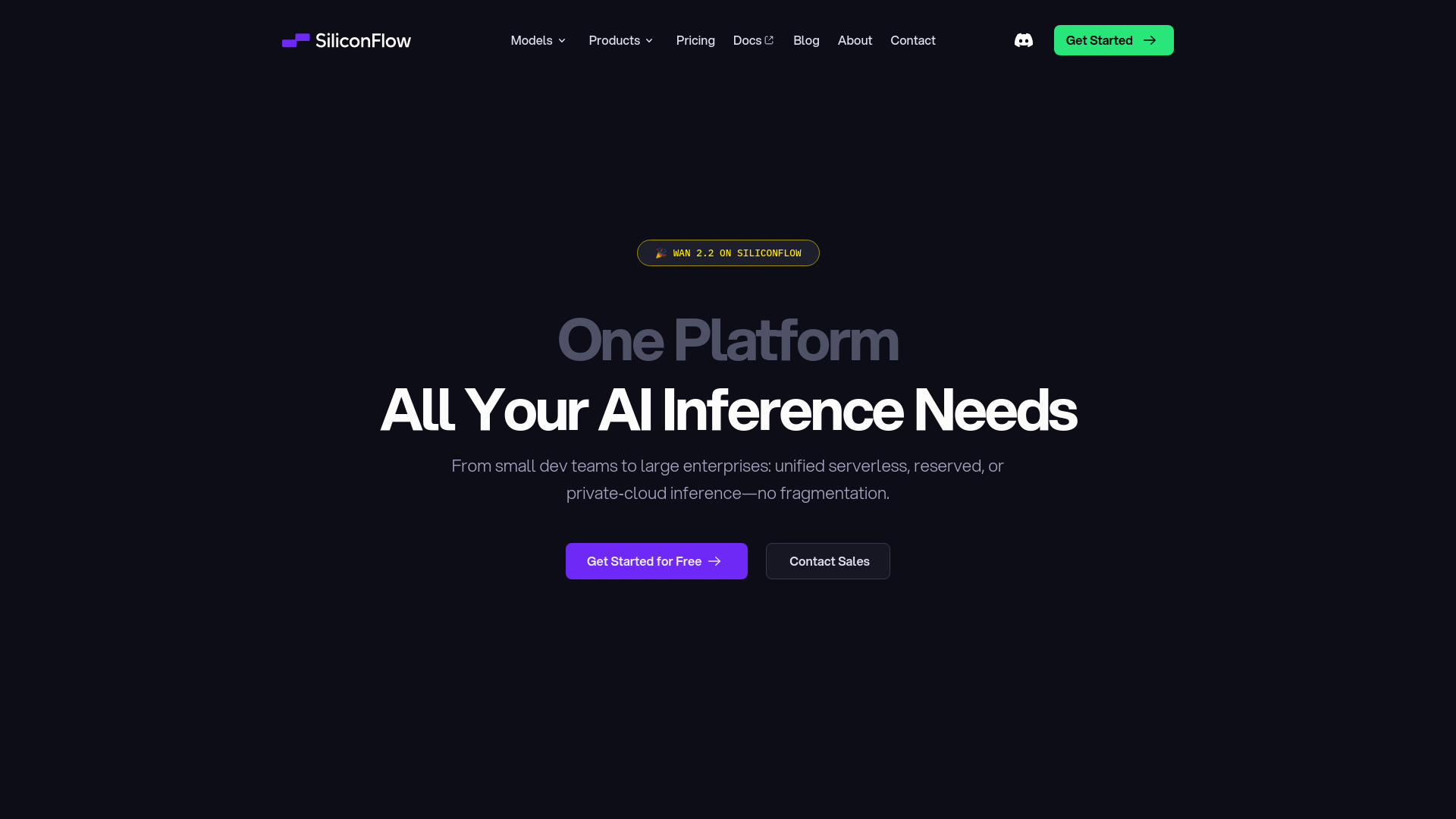
SiliconFlow
Open Website-
Tool Introduction:Unified API for top AI models plus elastic cloud to build and run apps.
-
Inclusion Date:Nov 06, 2025
-
Social Media & Email:
Tool Information
What is SiliconFlow AI
SiliconFlow AI is an AI infrastructure platform that provides unified API access to a wide range of cutting-edge AI models and scalable cloud deployment. Developers and enterprises can run text generation, embeddings, and multimodal inference through a single, consistent interface, then move from prototype to production with managed GPU resources and autoscaling. With built-in observability, secure access controls, and cost governance, SiliconFlow AI streamlines the entire lifecycle of AI applications—so teams can build, integrate, and operate reliable AI features without managing complex model serving or hardware.
Main Features of SiliconFlow AI
- Unified Model API: Access popular language and multimodal models for text generation, summarization, embeddings, and more through a consistent endpoint and schema.
- Scalable inference: Managed GPU/CPU infrastructure with autoscaling for steady throughput, low latency, and reliable production performance.
- Serverless deployment: Move from sandbox to production without provisioning clusters; versioning and safe rollouts help reduce downtime.
- SDKs and REST: Simple REST API and SDKs for common languages to speed up integration in web, backend, and mobile apps.
- Observability and analytics: Monitor latency, token usage, and error rates; set budgets and alerts to control costs.
- Security and governance: API key management, rate limiting, encryption in transit, and private integration options for enterprise needs.
- Response streaming and batching: Stream tokens for interactive UX and batch requests to optimize cost and throughput.
- Flexible routing: Swap models or add fallback logic without changing application code to improve resilience.
Who Can Use SiliconFlow AI
SiliconFlow AI suits software teams building AI-enabled applications, including startups, SaaS vendors, system integrators, and enterprise product groups. Common users are full-stack developers who need a stable inference API, ML engineers who want managed model serving, and data teams implementing RAG, embeddings, and semantic search. It also benefits customer support teams deploying chatbots, content teams automating generation workflows, and IT leaders seeking scalable, governed AI across business units.
How to Use SiliconFlow AI
- Sign up for an account and create a project in the console.
- Generate an API key and review rate limits, quotas, and security settings.
- Choose a model (e.g., text generation or embeddings) and note the endpoint and parameters.
- Integrate via REST or an SDK; set authentication headers and request payloads.
- Enable response streaming, batching, or retries to meet latency and reliability needs.
- Deploy to production with autoscaling; configure budgets, alerts, and logging.
- Monitor metrics and iterate: adjust models, prompts, and routing based on performance.
SiliconFlow AI Use Cases
Teams use SiliconFlow AI to power customer support chatbots, multilingual Q&A, and knowledge assistants. Product search and recommendations leverage embeddings for semantic relevance and personalization. Content operations automate blog drafts, ad copy, and localization. Engineering tools integrate code completion and documentation summarization. In regulated industries, organizations can build retrieval-augmented generation (RAG) pipelines to summarize lengthy documents and accelerate research while keeping deployment governed and observable.
Pros and Cons of SiliconFlow AI
Pros:
- Unified access to multiple AI models with a consistent API.
- Managed, autoscaling infrastructure for low-latency inference.
- Built-in observability, budgeting, and cost controls.
- Flexible routing and streaming for resilient, responsive apps.
- Enterprise-ready security features and governance options.
Cons:
- Service dependencies and potential vendor lock-in for core workloads.
- Network latency considerations versus fully on-prem deployments.
- Costs can vary with traffic spikes without proper budgeting.
- Model availability and versions may change over time and require updates.
FAQs about SiliconFlow AI
-
Which models does SiliconFlow AI support?
It provides access to a wide range of language and multimodal models. The exact catalog evolves, so consult the official documentation for the current list and versions.
-
How do I integrate it into my app?
Use the REST API or available SDKs, authenticate with an API key, and call the chosen model endpoint with the required parameters and payload.
-
Is my data secure?
Requests are protected with standard encryption and access controls. Review the platform’s security and data retention policies to meet your compliance needs.
-
Can I scale automatically with traffic?
Yes. Autoscaling adjusts capacity to maintain performance during demand spikes, and you can set budgets and alerts to manage costs.

